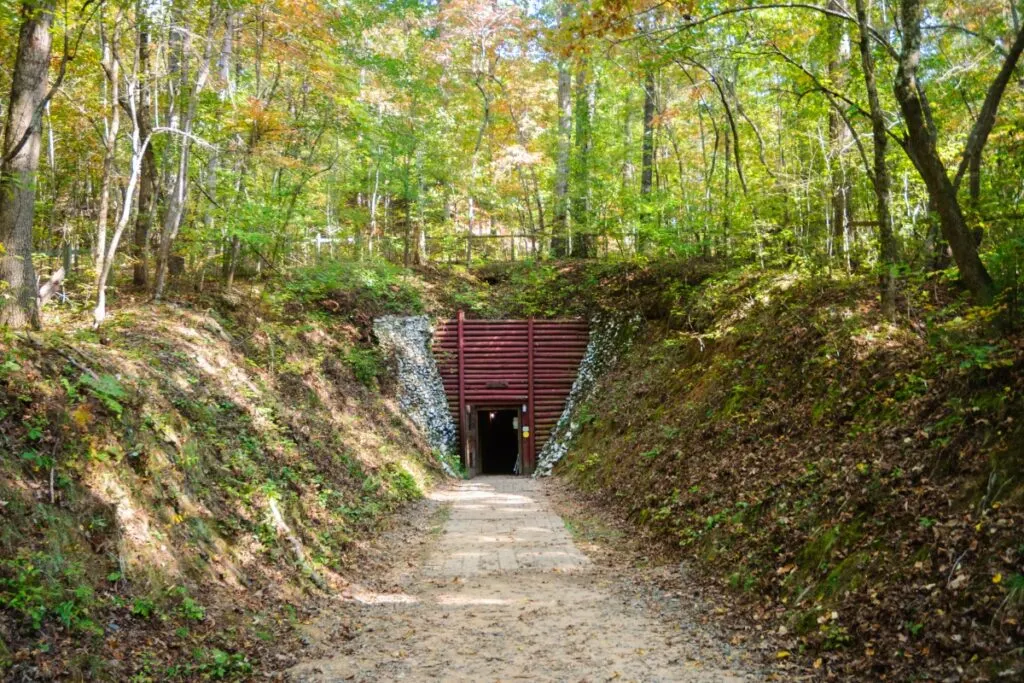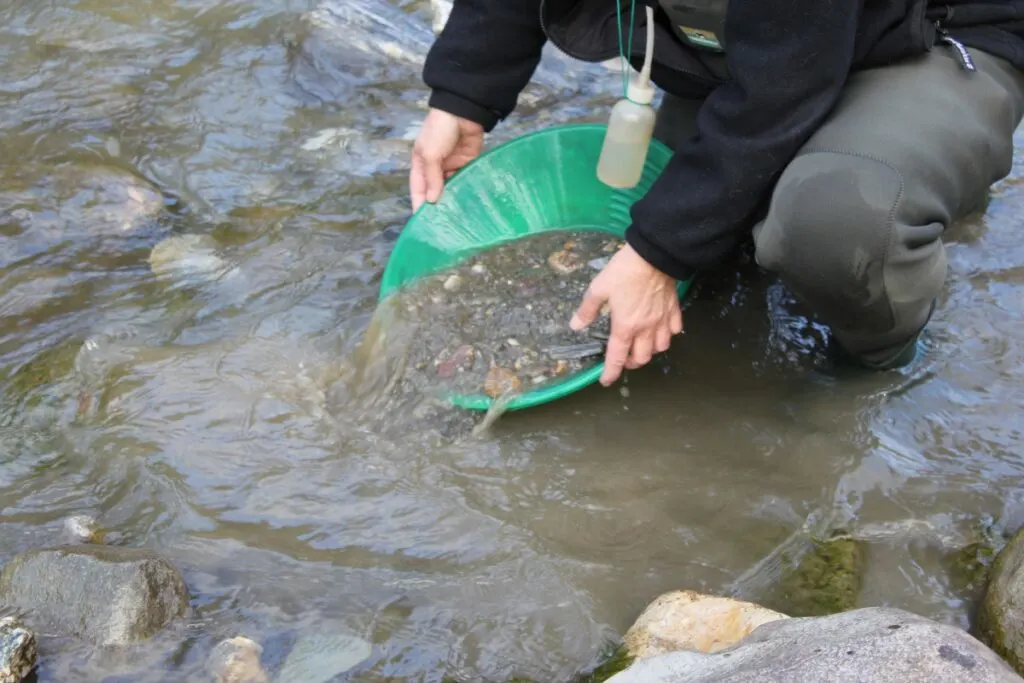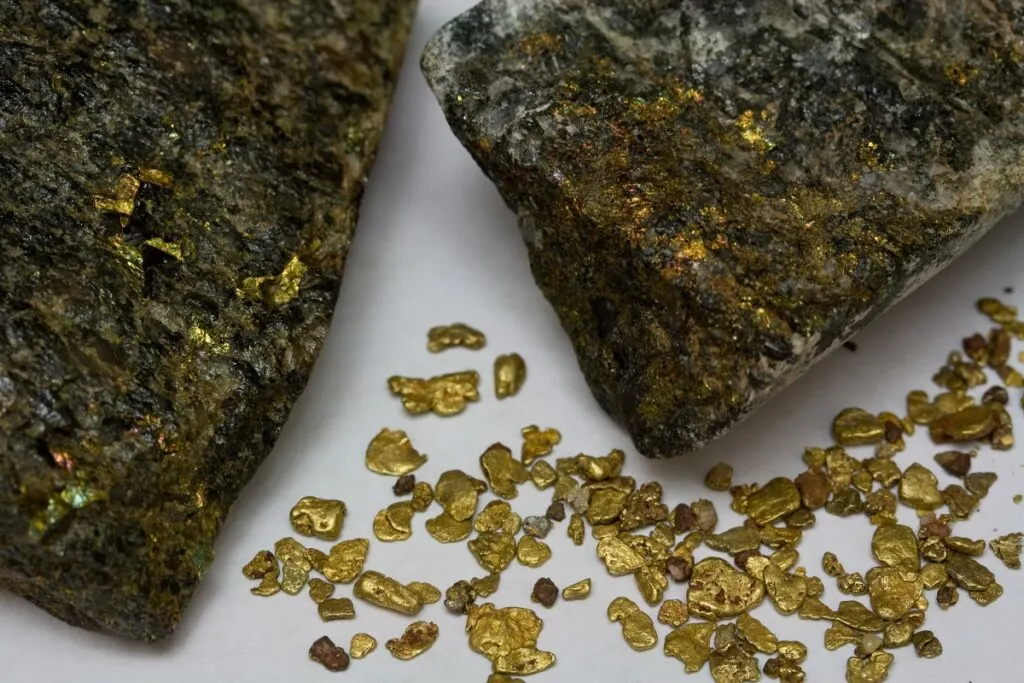As an Amazon Associate, I earn from qualifying purchases with no additional costs for you.
North Carolina’s golden legacy extends deeper than any mine in the state. From the beginning of America’s first gold rush in the early nineteenth century to the present, the state has consistently proven to be a glittering destination for gold prospectors.
Its diverse geology, rich history, and welcoming community continue to attract precious yellow metal seekers. Whether you are a seasoned prospector with years of experience or a novice hoping to find your first nugget, the Tar Heel State’s gold-bearing regions will surely delight and inspire you.
In this article, we’ll explore seven of the best places to prospect for gold in North Carolina, look into the fascinating stories behind these locales, and navigate the important legal aspects you need to know before you start your gold-seeking adventure.

If you want to check out the best tools and equipment for gold prospecting, you can find them by clicking here (Amazon link).
7 Best Places for Gold Prospecting in North Carolina
These three sites offer a blend of experiences for gold prospectors in North Carolina. From the peaceful to the immersive retreat, these locations cater to different preferences and skill levels, making gold panning accessible to all.
Reed Gold Mine
Known as the birthplace of American gold mining, Reed Gold Mine is where 12-year-old Conrad Reed made a monumental discovery in 1799 — a shiny, 17-pound gold nugget used as a doorstop for several years before its true value was recognized.
This pivotal find sparked the nation’s first gold rush decades before California’s famous one. Now a designated National Historic Landmark, Reed Gold Mine operates as an educational site open to the public.
Visitors can tour restored mine tunnels, explore exhibits in the visitor center, and even try their luck panning for gold in the designated area.
Cotton Patch Gold Mine
Cotton Patch Gold Mine, located in the heart of North Carolina’s gold country, has a storied history dating back to the early days of America’s gold mining era.
With verified gold finds, and an operational gold mine, Cotton Patch extends a unique offer — a pay-to-dig operation allowing visitors to prospect for gold on the property.
Additionally, the mine hosts special events and group digs, providing a community-centered experience while nurturing the excitement of potential discoveries.
Vein Mountain, McDowell County
Vein Mountain is recognized as a favored locale for prospectors in the North Carolina gold belt. Known for its substantial gold deposits, it still holds untapped potential, with many areas yet to be fully explored.
The Vein Mountain region offers a blend of gold panning, metal detecting, and sluicing opportunities, making it a veritable playground for gold seekers of all levels.
Carolina Slate Belt
Carolina Slate Belt, spanning across several counties: The Carolina Slate Belt, a geologic formation stretching across multiple counties, is a significant source of gold deposits. It has been extensively mined since the 19th century yet still yields gold.
Several active commercial operations coexist with recreational gold mining sites, illustrating the richness of this area.
In addition, the diversity of locations in the belt caters to different gold prospecting methods, making it an alluring prospect for hobbyists and professionals alike.
TIP: Find out my recommended products if you are looking for the best tools you need to find gold (Amazon link):
- Gold Metal Detector: Bounty Hunter TK4 Tracker
- Gold Pan: Stansport Deluxe Gold Pan
- Sluice Box: Stansport Aluminum Sluice Box
- Shovel: Radius Garden Carbon Steel Shovel
- Snuffer Bottle: Stansport Snuffer Bottle
Second Broad River, Rutherford County
The Second Broad River in Rutherford County is one of the favored sites for gold panning in North Carolina. This river has consistent quantities of gold flakes, which appeal to amateur and experienced gold prospectors.
Its rich gold history dates back to the North Carolina gold rush in the early 1800s. The river’s flow exposes new material, continually renewing the opportunity to find gold.
Beyond the prospect of finding gold, the Second Broad River offers a tranquil and scenic environment that makes the prospecting experience even more enjoyable.
Thermal City Gold Mine, Rutherford County
The Thermal City Gold Mine is a unique prospecting site in North Carolina. Not only does it offer a high potential for gold discovery, but it also features a variety of amenities that turn a gold prospecting trip into a complete vacation. This location is privately owned and operates as a pay-to-dig site.
At Thermal City, visitors can camp, prospect for gold, and partake in communal activities like group mining and treasure hunts, offering a mix of solo and community experiences.
The treasure hunts are particularly popular, involving competitions where participants search for gemstones, fossils, and other unique items along with gold.
Eureka Gold Panning, Greensboro
Eureka Gold Panning in Greensboro offers a unique educational gold prospecting experience. Ideal for beginners, this site offers hands-on lessons, teaching visitors the techniques and methods required to pan for gold successfully.
One of Eureka’s key offerings is its welcoming and educational environment. They have created a place where beginners can become comfortable with gold panning by focusing on teaching and learning.
Following the lessons, visitors can practice their newly acquired skills in the on-site creek, providing a complete learning and practice experience in one location.
TIP: Simple gold panning is among the most allowed gold prospecting techniques you can use almost anywhere. Check out other effective methods in the article below:
The 7 Most Effective Gold Prospecting Techniques Explained
Active, Old, And Abandoned Mines
North Carolina’s mining history is rich and varied, with active, old, and abandoned mines scattered across the state. These mines have shaped the state’s economic development and continue influencing its landscape and character.
Active Mines
Haile Gold Mine, Lancaster County
While not in North Carolina, but just across the border in South Carolina, the Haile Gold Mine in Lancaster County is a significant regional operation. It is one of the largest gold mines in the eastern United States, having produced gold intermittently for over 180 years.
Feldspar and Mica Mines
Although gold mining is historical, the state has several active mines extracting other minerals. North Carolina leads the country in producing feldspar, mica, and lithium, mined from the western part of the state.
Old Mines
Reed Gold Mine, Cabarrus County
The Reed Gold Mine is essential to the state’s mining history. As the location of the first documented gold finds in the United States, this mine played a significant role in launching the nation’s gold mining industry.
Although no longer active, the Reed Gold Mine is now a state historic site where visitors can learn about the history of gold mining and try their hand at panning for gold.
Bechtler Mint Site Historical Park, Rutherford County
Christopher Bechtler minted the first $1 gold coin in America 17 years before the U.S. Mint. Although not a mine, the site commemorates the gold mining history that led to its creation.
Abandoned Mines
Like many states with an extensive mining history, North Carolina has numerous abandoned mines. These sites pose a potential risk to public safety and the environment and serve as historical artifacts of the state’s mining past.
Carolina Gold Rush Sites
Numerous abandoned mines remain from the Carolina gold rush in the early 19th century, primarily in the central Piedmont region. Many of these sites are on private land and inaccessible to the public.
Copper and Iron Mines
Besides gold mines, the state is home to abandoned copper and iron mines, primarily in the Appalachian Mountains.
When visiting a mining area, it is necessary to respect the land and any potential dangers, such as unstable mine shafts or hazardous materials. Also, make sure to obtain proper permissions and follow all rules and regulations.
TIP: Starting your gold prospecting journey depends on your seriousness and knowledge. Check out the ultimate guide on starting gold prospecting in the article below:
Ultimate Beginner’s Guide: How To Start Gold Prospecting
Gold Prospecting Clubs in North Carolina

North Carolina, which has a long history of gold mining, has several clubs and organizations that appeal to those who enjoy the joy of prospecting.
These clubs offer resources, support, and a sense of community for both novice and experienced prospectors. Some of the prominent gold prospecting clubs in North Carolina include:
The Carolina Prospectors
Based in Statesville, NC, Carolina, Prospectors is a store and club for hobbyists and enthusiasts. They offer prospecting supplies and serve as a hub of information for those interested in gold prospecting and metal detecting in North Carolina and the Southeast.
They also organize outings and events for members to share their love for prospecting.
Matthews North Carolina Gold Prospectors Association:
This is a local chapter of the Gold Prospectors Association of America (GPAA), a national organization dedicated to promoting the hobby of recreational gold prospecting and metal detecting.
The Matthews chapter conducts regular meetings, seminars, demonstrations, and outings to allow members to share knowledge, learn new techniques, and practice their gold prospecting skills.
Vein Mountain Recreational Miners Club
Located in Nebo, NC, within the Vein Mountain region, this club offers members a campground and several acres of prospecting lands.
Members can prospect for gold and gemstones at Vein Mountain and participate in planned outings and events. In addition, the club aims to promote fun, fellowship, and education in prospecting.
Mountain Creek Gold Mine
While not a club, Mountain Creek Gold Mine offers a unique community experience.
Located in New London, North Carolina, they offer pay-to-dig experiences where you can prospect for gold and gemstones, providing a welcoming atmosphere that encourages sharing tips and techniques.
TIP: Nothing in this world is impossible, and finding gold in your backyard is rare but can never be ruled out. Find out helpful tips in the article below:
Guide: PRO Tips On How to Find MORE Gold in Your Backyard
Gold Panning Tours In North Carolina
Gold panning tours in North Carolina are a great way to learn about the state’s rich gold mining history, gain hands-on experience with gold panning techniques, and even find your precious gems or grains. Some of the most popular gold panning tours in North Carolina include:
Reed Gold Mine, Cabarrus County
The Reed Gold Mine is where gold was first discovered in America, leading to the nation’s first gold rush. Now a state historic site, Reed Gold Mine offers guided tours of the mine’s historic buildings and underground tunnels.
Visitors can learn about the mine’s history and even pan for gold. Although the gold panning season and availability may vary, it typically occurs between April and October.
Cotton Patch Gold Mine & Campground, New London
Cotton Patch offers pay-to-dig experiences, where visitors can pan for gold in the creek that runs through the property.
They also provide instructions for beginners, making it a family-friendly option. Equipment rental is available onsite, and the staff can guide you on how to find the best spots.
Mountain Creek Gold Mine, New London
Mountain Creek Gold Mine offers prospectors pay-to-dig experiences. They provide gold panning, high banking, and dredging for your gold prospecting adventure.
They also offer guided tours of the property, during which you can learn about the history of the mine and the techniques used to extract gold.
Thermal City Gold Mine, Union Mills
This site offers a real gold-panning experience and an onsite camping option. They offer gold panning, high banking, and dredging. Experienced prospectors run their guided tours, which include instructions on gold panning and the history of the mine.
TIP: The gold sluice box is a time-saving alternative to the traditional panning for gold. Check out helpful tips on using the sluice box correctly in the article below:
Find More Gold: Tips On How To Use Sluice Box Properly
The Legality of Gold Prospecting in North Carolina

Gold prospecting in North Carolina is subject to specific laws and regulations, ensuring the protection of natural resources and private properties.
Land Ownership
Determining the land ownership where you want to prospect is essential. On federal lands, prospecting is generally allowed, subject to certain restrictions. You need to verify the regulations on state-owned lands with the relevant state agency. On private lands, you need the owner’s permission.
Permits
You might need a permit to prospect for gold on some public lands. Contact the U.S. Forest Service or the Bureau of Land Management for federal lands. Contact the North Carolina Department of Natural and Cultural Resources for state lands.
Environmental Protection
North Carolina has regulations to minimize the environmental impact of prospecting. These may restrict activities such as in-stream prospecting to safeguard aquatic ecosystems.
Prospecting Methods
Specific prospecting methods may be limited or prohibited. Hydraulic mining and the use of chemicals, for instance, are generally banned due to their potential environmental damage. However, panning, sluicing, and metal detection are usually allowed.
Remember, laws can change over time and may also vary depending on the specific location within the state. So, it’s crucial to do your due diligence and check the current laws before you set off on your gold prospecting adventure.
Do I Need a Permit to Pan for Gold in North Carolina?
Gold panning generally falls under the “casual use” regulations for prospecting on public land, which does not require a permit.
However, it’s essential to verify with the managing agency of the land in question because rules can vary by location and can change over time. For instance, in areas managed by the US Forest Service, such as national forests, gold panning is usually considered a recreational activity and does not require a permit.
But, there may be regulations on the kind of equipment you can use and restrictions to prevent impact on natural resources. If you plan to pan on state or private lands, you may need permission from the respective owners or managers.
Where Can I Legally Pan for Gold in North Carolina?
Discover top locations for gold panning, rules to follow, and tips to maximize your prospecting experience.
Reed Gold Mine
This site is located near Charlotte, NC. Not only is it open to the public for tours, but there is also a designated area where visitors can pan for gold. Gold panning is seasonal and available from April through October.
Uwharrie National Forest
This forest spans over 50,000 acres and is located in North Carolina’s Montgomery, Randolph, and Davidson Counties. Certain sections of the river here are open to gold panning.
Pisgah and Nantahala National Forests
Both these national forests offer locations where gold panning is allowed. It is important to note that you must pan in a manner that avoids disturbance to other resources, particularly aquatic plants and animals.
Various Gold Mines
There are private gold mines in North Carolina that allow public panning. For example, the Cotton Patch Gold Mine & Campground in New London, North Carolina, will enable guests to pan and dredge for gold on their property for a fee. They also offer camping, so it’s possible to make it a gold-panning vacation.
TIP: Gold panning is legal in the U.S.; however, you must remember that every state has gold panning laws. Find out the complete guide on gold panning law in the article below:
Complete Guide: Is Gold Panning Legal & Where Can You Pan?
Tips on Getting a Gold Claim in North Carolina
Obtaining a gold claim in North Carolina involves a detailed process. Here are some critical steps and tips:
Research
Start with the Bureau of Land Management (BLM), which maintains active and closed claims records.
You can use the BLM’s LR2000 database to search for active claims and their GeoCommunicator tool to map them out. Check with local county offices for claims records, as well.
Stake Your Claim
In North Carolina, a mining claim can be staked for placer (deposits found in sand or gravel) or lode (deposits found in rock).
You’ll need to physically stake the corners of your claim and post a location notice. The exact process and requirements can vary, so be sure to review North Carolina’s specific laws and regulations.
File with the County and BLM
After staking your claim, you must file a copy of the location notice with the County Recorder or Register of Deeds in the county where the claim is located. You must also file a location notice with the BLM State Office within 90 days of staking the claim. Filing fees vary.
Maintain Your Claim
To maintain your claim, you must perform a certain amount of work or improvements annually and pay a maintenance fee to the BLM. Failure to meet these requirements can result in loss of the claim.
TIP: Find out my recommended products if you are looking for the best tools you need to find gold (Amazon link):
- Gold Metal Detector: Bounty Hunter TK4 Tracker
- Gold Pan: Stansport Deluxe Gold Pan
- Sluice Box: Stansport Aluminum Sluice Box
- Shovel: Radius Garden Carbon Steel Shovel
- Snuffer Bottle: Stansport Snuffer Bottle
Wrapping Up
Gold panning in North Carolina, a state rich in gold history, can be a rewarding hobby if done responsibly and legally.
Remember, even when panning on public lands, there may be restrictions and guidelines to follow. If you wish to stake a claim for a more serious endeavor, be prepared to meet the state’s specific requirements.
TIP: You need to know how gold deposits occur to understand which rocks to look for when prospecting. Find out more in the article below:
5 Rocks You Need To Look For When Gold Prospecting (+ Why)
